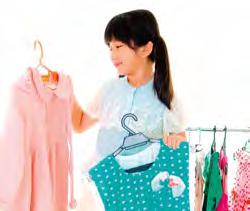
3 minute read
1.3 Why did you choose that?
1 How do you choose clothes?
I choose styles and colours I like.
I choose sports clothes that let me move easily. ✓ Analysis ✓ Evaluation ✓ Refl ection
2 What is the difference between human-made materials and natural materials? Write a defi nition for each. 3 Read the text. What are the advantages and disadvantages of each type of material?
www.Curious Kids…
Textiles
Synthetic fi bres are human made. They are strong, do not need much ironing and last a long time.
They are a good choice for clothes because they are often soft. They are also cheaper than natural fi bres. Some people do not like them because they can melt if they get too hot. They can also catch fi re easily. Synthetic fi bres are not biodegradable.
Natural fi bres are a popular choice for people who care about the environment.
They are recyclable. Chemicals are not needed to produce them. They are good at keeping things the same temperature and do not irritate the skin. However, natural fi bres are less strong than human-made fi bres. They are also heavier.
They need more ironing and they do not last as long.
Did you know?
Historians have discovered fl ax fi bres that are more than 34,000 years old, making them the oldest fi bres known to have been used by humans.



Sample Pages
Vocabulary
fl ax fi bres: obtain ed from the inner bark of the stem of the fl ax, a fl owering plant, and used for linen fabrics




4 Read and respond.
a What does this infographic show? b Answer the questions in part 1 on the worksheet. c Complete the sentences in part 2 on the worksheet to report on this information.
Concerns about how textiles are made
5 What concerns you most about how textiles are made?
a Do a class survey to fi nd out what people are most concerned about. Copy and complete the tally chart.
Key term
survey: a way to fi nd out information from a lot of different people by asking them all the same question What is your opinion now about fabric choices? Have your opinions changed since the start of the lesson? Why, or why not? We surveyed 8000 people from different countries about their concerns over how textiles are made. The tiny bits of plastic from fi bres that end up in oceans.
United Kingdom, Germany, Czech Republic
The amount of chemicals needed to make synthetic fi bres.
Australia, United States, Italy, India
The bad gases that go into the air when synthetic fi bres are made.
Mexico
The amount of chemicals put on cotton plants to keep insects away.
China and Brazil
Class tally chart What are you most concerned about? Tally marks Total
Tiny bits of plastic fibre ending up in oceans. Harmful gases from human-made products going into the air. The amount of chemicals put on cotton plants to keep insects away. The amount of chemicals produced by human-made fi bres.
I don’t have enough information to have an opinion. b How do your opinions compare to the opinions in the infographic? c Explain and compare your own opinions with the opinions in the survey. Use the worksheet.
Key term Sample Pages opinion: a thought or belief about something, which cannot be proved to be true or false
Talking point











